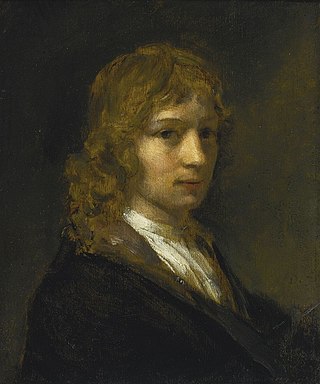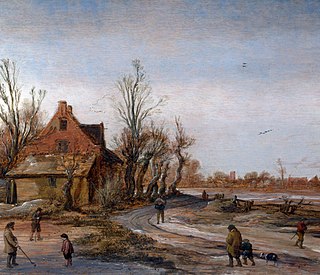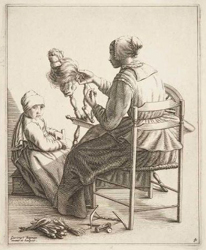


Roelant Roghman (14 March 1627 - 3 January 1692) was a Dutch Golden Age painter, sketcher and engraver. [1]



Roelant Roghman (14 March 1627 - 3 January 1692) was a Dutch Golden Age painter, sketcher and engraver. [1]
Roghman was born in Amsterdam, the son of the engraver Henrick Lambertsz Roghman and Maria Jacobs Savery. His mother was a daughter of the Savery family, and Roghman became a student of his namesake and great-uncle, Roelant Savery. According to Houbraken, he only had one eye, but painted in a rough and ready way, that perhaps was the result of his eyesight. He specialized in landscapes, and in later life became a history buff, working on several prints of old castle ruins and defunct family estates based on drawings he made during travels in his youth. He was a follower of Rembrandt and Hercules Seghers. [1] Houbraken claimed that in his youth he had been a friend of Rembrandt and Gerbrant van den Eekhout. [2]
Roghman worked on one of his print series with his sister Geertruydt in (ca. 1645-1648), under the title Plaisante Landschappen (pleasant landscapes) by the printer Claes Jansz Visscher. His other sister Magdalena was also an engraver. Their landscape series of more than 200 prints, showing mostly castles and landed estates in the Dutch provinces of North Holland and Utrecht, were very popular. He never married, and died a resident of the old men's almshouse in Amsterdam.
Aside from his sisters, he was the teacher of Jan Griffier and Pieter Wouwerman. [1] [2]

Willem Drost was a Dutch Golden Age painter and printmaker of history paintings and portraits.

Allaert van Everdingen, was a Dutch Golden Age painter and printmaker in etching and mezzotint.

Esaias van de Velde was a Dutch landscape painter.

Roelant Savery was a Flanders-born Dutch Golden Age painter.

Hendrik Martenszoon Sorgh was a Dutch Golden Age painter of genre works.

Gillis Claesz. de Hondecoeter or d'Hondecoeter was a Dutch painter, working in a Flemish style, painting landscapes, trees, fowl and birds. Later on d'Hondecoeter painted in a more Dutch, realistic style. Gillis was the father of Gijsbert d'Hondecoeter and grandfather of the more successful Melchior d'Hondecoeter and Jan Weenix. His daughter Josijntje married Jan Baptist Weenix.

Jan Griffier was a Dutch Golden Age painter who was active in England, where he was admitted to the London Company of Painter-Stainers in 1677.

Jan van de Velde the younger was a Dutch Golden Age painter and engraver of animal, landscape and still-life subjects. He was the son of Jan van de Velde the Elder and the father of the still life painter Jan Jansz van de Velde.

Frederik de Moucheron was a Dutch Golden Age landscape painter and draughtsman. He mainly produced (Italianate) landscapes that were furnished with human and animal figures by various colleagues.

Willem or Guiliam van Nieulandt, sometimes Nieuwelandt (1584–1635) was a Dutch Golden Age painter, engraver, poet and playwright from Antwerp.

Claes Janszoon Visscher was a Dutch Golden Age draughtsman, engraver, mapmaker, and publisher. He was the founder of the successful Visscher family mapmaking business. The firm that he established in Amsterdam would be passed down his generations until it was sold to Peter Schenk.

Antonie Waterloo was a Dutch Golden Age landscape painter.

Jacob Savery or Jacob Savery the Elder was a Flemish painter, etcher and draughtsman. He was trained in Antwerp and later moved to the Dutch Republic after 1584. He specialised in still lifes, animals, landscapes en genre paintings.

Johannes Glauber, was a Dutch Golden Age painter.

Pieter Wouwerman was a Dutch Golden Age landscape painter.

Jacobus Stellingwerff, was an 18th-century artist from the Northern Netherlands.
Marten Heemskerck van der Heck, was a Dutch Golden Age painter.

Geertruydt Roghman, was a Dutch Golden Age painter, engraver, and printmaker.

Salomon Savery (1594–1683) was an engraver from the Northern Netherlands.

Haerlempjes refer to a specific genre of landscape painting that includes a view of Haarlem. It is used most often to refer to Jacob van Ruisdael's panoramic views of the city, but the term is derived from mentions in Haarlem archives as a type of painting included in household inventories. The diminutive suffix "pje" would denote a small, cabinet-sized painting, but even the largest landscapes may be referred to as Haerlempjes today.